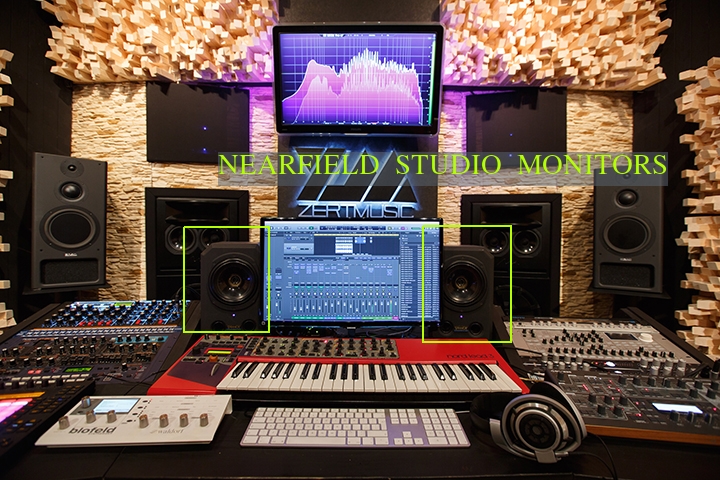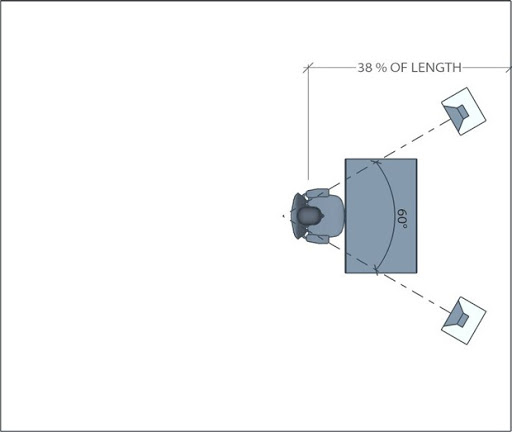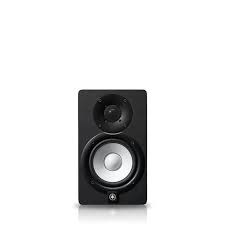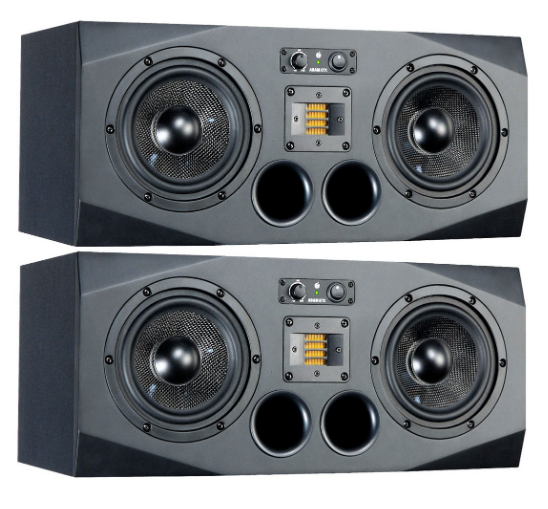When you get to know that there are different types of studio monitors, it might get confusing which ones to use.
In this article we will cover the main differences between near-field, mid-field and far-field monitors and when to use which.
They are diversified into different types because placement of the monitor matters. Placement of the monitors shapes the way you hear frequencies by how far the speaker is. Due to this reason there are different types of speakers to handle this situation.
NearField Studio Monitors

These monitors are usually perceived in common people terminology as “studio monitors”. So nearfield monitors are the speakers that you put in front of you, that fits on your desk. And they are used for the main work of producing or mixing a track.
These monitors are more precise in their frequencies so that engineers could make the right decision of which frequencies to boost and which ones to cut out.
When To Use NearField Monitors?
Nearfield monitors are usually used in the beginning of the mixing phase.
Why?
Because these speakers are the most precise in their sound. Also they are placed closer to the listener, so you are able to hear the sound better.
These factors allow you to hear the mix better and avoid mixing mistakes that you might encounter with the other types of studio speakers.
NearField Studio Monitors Positioning

It has to make a perfect triangle in order to take nearfield monitors the best effect. Both speakers should have a 60 degree angle pointing to your face. Talking about height positioning, the speaker has to be pointing straight to your ear level.
As a quick placement test, you can point with your index finger to the speaker imagining the perfect triangle and test if the speakers are at the same distance from you and are directing to you correctly.
The Best NearField Studio Monitors

These monitors have a very precise sound. Low end does not make the sound muddy, so that you are able to hear clearly every frequency and easily apply mixing decisions. I’ve personally used these monitors for 8 years, and they are serving me since. Always happy to use them.

Adam Audio A7X Powered Studio Monitor
These are a bit pricier, but have a more pleasing sound. It still maintains truthful sound, but also has a solid low end range, so that you are able to mix the bass more easily than with other speakers.

Genelecs are one of the most trusted brands in the music industry. It is enough to hear how clear the sound is achieved with these monitors and is hard to resist not having it.
Outstanding high and low end reproduction, that makes the mixing and production seamless and professional!
MidField Studio Monitors

They are usually used more often in bigger studios since they are bigger and of course more expensive. They have minimum 10 inch speakers and provide a wider soundscape sound and have a bigger low end spectrum.
When To Use MidField Studio Monitors?
Midfield studio monitors usually take part after the song is starting to get into the final shape. Then these monitors help you to get the “feeling” of the song.
And it is essential in the production process. Because using only nearfield studio monitors you might lose the vibe of the track and depend too much on the sound and mixing details, that usually is not the main part of the song.
If the song does not feel right, then the rest of the work is pointless!
So make sure to have a good pair of midfield studio speakers set up in your studio in order to produce great tracks.
MidField Studio Monitors Positioning
The placement of these monitors usually is about 2 meters from the listener. And the monitors are set up vertically so that low and high range frequencies would be translated to the same level.
The Best MidField Studio Monitors

ADAM A77X are the real monsters, that are perfectly frequency balanced and thoughtfully designed to fit into the studio as midfield monitors. They are known for their crisp detail sound, that makes working with songs so much more enjoyable.
Since they are huge speakers, they are designed to be placed horizontally so that frequencies would lay in the same level, which makes it reproduce sound even better.
Far Field Studio Monitors
As the name says itself, these monitors are used far away from the listener. It is usually not used for the in depth mixing phase. Far field monitors are used as reference speakers. When producing or mixing a track ears usually get used to the sound and after some time they do not hear the bad frequencies and it gets hard to mix. For this reason, reference speakers became a must have thing for producers and engineers.
So far field monitors are placed far away from the listener and are used to listen to the song from a different standpoint.
When To Use Far Field Monitors?
It is the same case as with midfield monitors, that you are using them to have a feeling moment of your song. You use far field monitors after the song mix is getting to the finish line.
Far Field Studio Monitors Positioning

In professional recording studios far field monitors are mounted to the wall and distance between speaker and listener is about 4 meters.
The Best Far Field Studio Monitors

So please welcome the heavier artillery players like Adam S6X. They are designed for bigger music production studios. Adam S6X are huge and still able to avoid flat sound and reproduce dynamic sound. Even complex orchestral arrangements can be easily analysed and arranged with these far field monitors.
Adam S6X price starts at around $21.000.

Let’s have a look at another big boy Adam S7A MK2 that is leading industry standard for far field monitors currently. This one costs around $29.000.
Tweeter is designed in Berlin. It is made in a way that does not give ear fatigue when listening at high volume.
Advanced dynamic range reproduction that makes it one of the best far field monitors for orchestral analysis and arrangement.
Bass reproduction has a very low compression.
And most importantly, unbiased reproduction of a wide range of frequencies (linear 20hz to 50kHz frequency range).
Which Type Of Studio Speaker Is The Best?
If you are not able to have all of these options, it is definitely recommended to use nearfield monitors.
Why?
Even though you would be having a better time producing with midfield monitors, nearfield speakers will give you more accurate information about the sound, so that you will be able to make a professional mix.
By having only midfield or far field monitors it would not be possible, or as not easy as having nearfield speakers.
The reference sound or the vibe sound is possible to be achieved using your “car test” (playing your track on the car speakers). Or playing it at the club if there is such an opportunity.
What To Consider Before Buying Studio Monitors?
Truthful Sound
Make sure that your studio monitors that you are planning to buy are not bass boosted or enhanced in its frequencies to sound more pleasing. Studio monitors have to have a linear frequency range so that you would be able to hear real sound and make correct decisions when mixing the track.
Studio Size
If you have a tiny studio apartment, it is a sure thing that far field studio monitors will not be the best scenario for you. So make sure the speakers are aligned to the studio space.
Music Style
Some studio monitors might have better low end representation. Others might have a better mid, high frequency sound with crisp detail to it. It might depend on your music style to which ones can be a better fit for you. If you love to work with bass driven music Adam Audio A7X speakers might be more pleasing and beneficial to work with. Whereas Yamaha HS-8 have a clear mid-high frequency range that will be irreplaceable when working with acoustic guitars or other instrumental tracks.
What To Consider After Buying Studio Monitors?
Studio Monitors Placement
This is one of the most underrated factors of having a good sound. Most music producers invest a serious amount of money into good speakers and then just place them on the desktop without overthinking it.
However, placement might have a drastic effect on the sound.
It is a whole science about how the studio monitors should be placed. There are a lot of variables that take part into putting your speakers correctly.
We will cover at least the basics of a studio monitor placement. It should be enough to at least not make them sound worse as they should.
- Make sure speakers are headed to your head. The position of speakers and your head has to make a perfect triangle in order to take the best effect
- Leave enough space between the back of the speaker and the wall. Low frequencies are longer than higher frequencies. For most of the studio monitors the bass woofer is in the back, so it might corrupt the soundwave and cause a “boundary effect”. To avoid that make sure to leave at least 1-2 feet from the wall. If your speaker’s bass is in the front (as in Adam Audio A7X) you can skip this step.
- Align speakers height level to your ear level, so that it would create a correct stereo image.
Acoustic Treatment For Studio Monitors
Without acoustic treatment even the most expensive studio monitors can be wasted and not give great results.
Make sure to control your sound in the studio as much as possible so that it makes sound resonate perfectly.
Make sure to check these steps to treat acoustics in your room:
- Set absorption panels in front of yourself in order to avoid early reflections
- Set acoustic panels on the side walls
- Set up bass traps in all of the top corners
- Set diffuser in the back of your studio in order to diversify reflected sound waves from the back.
To learn more about acoustic treatment make sure to check this article.
What Studio Monitor Size Is The Best?
Does the size matter in this case?
Jokes aside, actually there are four main differences how bigger sized monitors differs from smaller ones:
- Dynamic range. Big monitors have a wider frequency reproduction, what allows you to hear the sound in more depth and detail. That can definitely make you do better mixes!
- Less distortion. This is the same as the first point, but still worth mentioning due to the fact that it makes sound quality much better and more dynamic and alive which helps to feel the track and make adjustments accordingly.
- Deeper bass resonance. The bigger the speaker, the stronger bass sound can be produced. So this is important when mixing basslines and other low frequency parts.
- Further listening distance. In the bigger music production studios, it is necessary to handle the sound system perfectly even though the space is bigger. Thus big sized monitors help to solve this issue.
How Much To Spend For A Studio Monitors?
It highly depends on what level you are and how well the studio room is treated acoustically. For beginners, on the average, you should expect to spend around $500 – $1000. Studio speakers are not cheap, but they definitely will pay off in the long run since bad sound quality will not give you capabilities to do a good mixing part.
If you are an intermediate music producer, $1500 – $3000 is average what engineers spend for a pair of monitors. And it is the case if there are no reference speakers. If you are eager to go extra and have a pair of reference monitors, then the price might jump to $3000 – $5000 depending on what type of speakers are you planning to go for.
Do Studio Monitors Need A Subwoofer?
What Regular Studio Monitors Do Not Have Compared To A Subwoofer
If you are planning to work with nearfield studio monitors, which usually are about 5” – 8” size, in most cases they do not cover frequencies below around 40Hz.
In most cases you will not hear the difference if you do not do the perfect job at mixing in this range between 20-40Hz because most of the streaming platforms cut out all of these frequencies. You can see this on the radio, soundcloud or youtube, where the audio quality is processed and compressed.
What Problems Can Occur Without Using A Subwoofer
If you come to a proper club, it might shock you how muddy your song sounds on the huge speakers, where subwoofers are making the floor crack. And at this moment it might be too late to do some adjustments to your low end.
So, if you are planning to work with dance, hip hop or any other pop music genre, it would be an essential thing to have in order to make these low end mixes sound good.
The Best Studio Subwoofers To Have In Studio
The best case scenario would be to have the same brand or even the same model subwoofer as your studio monitors are. Usually brands incorporate a subwoofer to the full studio speaker set.

Yamaha HS8S Powered Studio Subwoofer 8”
This is designed to work with Yamaha HS-8. So if you are looking for a perfect studio monitor set, these would make a perfect and complete set.
Yamaha HS8S has 8” bass subwoofer and is capable of reproducing 22Hz – 150Hz frequency response.
Conclusion
I believe that’s it about near-field, mid-field and far-field studio monitors. I’ve covered essential subjects about what these terms mean, what are the best options according to mentioned studio monitor types. Also we’ve covered the positioning individually by every single type of studio speaker. And we gave you some tips on what to consider before buying monitors and what to do after buying them so that you would make the most out of them.
I hope this article has been helpful to you, and I wish you a great day!:)



Thank you for your reading. Join the conversation by posting a comment.